Chrome Industries Tensile Sling Bag Review
The Chrome Industries Tensile Sling Bag is crafted from durable, lightweight materials but lacks internal organization, which may turn away some travelers.
Our Verdict
Save time. Get access to brief summaries of our reviews so you can browse and make decisions more efficiently.
Pros
- Materials are durable and lightweight
- It can be packed down small for travel
- Comfortable for most use cases
Cons
- The seatbelt buckle can be tough to get used to
- Lack of organization may deter some travelers
- When fully packed, the strap can dig in
Technical Details
-
Capacity
7l
-
Weight (lb)
0.82 lb (0.4 kg)
-
Dimensions
7 in x 10 in x 4 in (17.8 x 25.4 x 10.2 cm)
Up to 11" width
-
Notable Materials
Recycled Nylon, Recycled Polyester, Polyurethane (PU), YKK Zippers, Duraflex Hardware, Aluminum
-
Manufacturing Country
Thailand
-
Warranty Information
Full Review
Get up to 10% off Chrome Industries • Join Pack Hacker Pro
We’ve tested a lot of Chrome Industries gear over the years, even some that use the same materials as the Tensile Sling Bag. It’s lightweight, has some of the features we’re used to seeing from Chrome, and remains durable. However, how does all of that come together? Let’s dive in and find out!
External Components
The primary pack materials are recycled nylon and polyester with a ripstop sailcloth for extra durability and a unique look—it’s comparable to X-PAC, which we dig. However, this won’t be everyone’s vibe, and we understand that. There are numerous colorways available, though, so most travelers will be able to find this sling in a color that they enjoy.
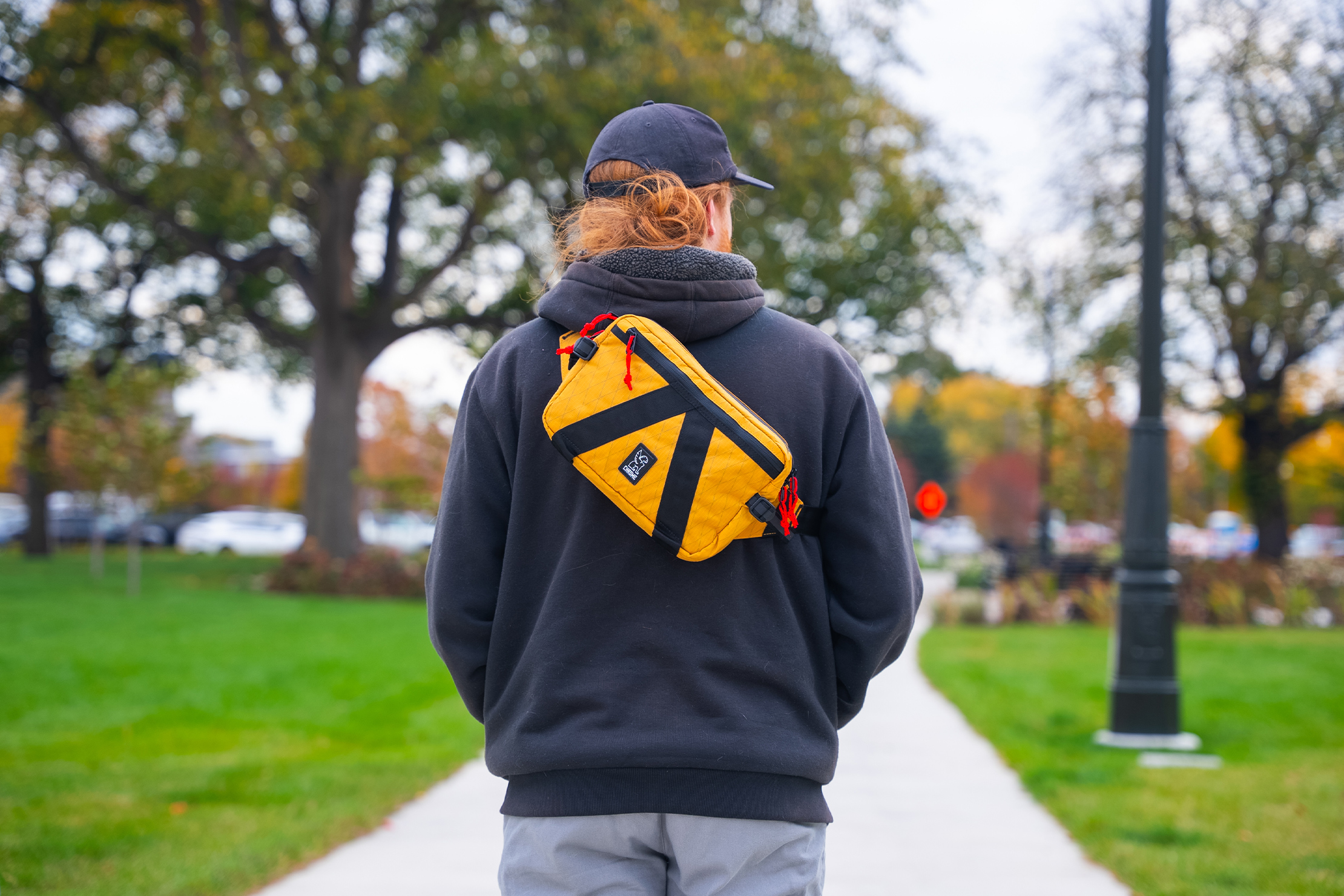
The exterior has Chrome’s trademark 5-bar webbing, which adds durability, structure, and flare to the pack. This sling was built for commuting, and the extra ruggedness that this feature adds is well worth it, even if you aren’t cycling or taking the bus to work. It enables the pack to hold its own, even when you don’t have it fully packed out.
When not in use, we’ve been able to compress this pack well. While durable, the materials are pretty thin. This makes it easy to stow it inside your daypack, travel backpack, or carry on luggage, no matter your destination. It isn’t marketed as packable, and it doesn’t compress down, but we’ve found this to work well.
The zippers on the Tensile are from YKK, which is an excellent sign. YKK is the best in the business, and this iteration doesn’t present any issues for us. They are AquaGuard models, which keep water at bay, a helpful feature for commuting or walks in the rain. The zipper pulls are red on this colorway, and they are easy to see and grab onto. Some other colorways have black pulls, which are more sleek but not as visible.
The hard plastic adjusters are from Duraflex, which is top-tier, too. They’re easy to manipulate and have held up well so far in testing. No issues to report here!

The strap closure is another Chrome Industries trademark: the seat belt style buckle. If you’re familiar with the brand, you probably knew this was coming. It’s durable, easy to use, and we think it looks rad. However, like the exterior aesthetic we mentioned earlier, it won’t be for everyone. You probably know whether you’ll like it by just looking at it, but it’s worth trying out in the store if you’re still on the fence.
There are compression straps on either side, which is helpful to make the pack smaller to fit inside another bag, to attach a travel water bottle, or to cinch it down before you hit the streets on two wheels.
The Chrome Industries logo is loud and proud, but it isn’t very distracting, so we don’t mind it.
Fit Notes
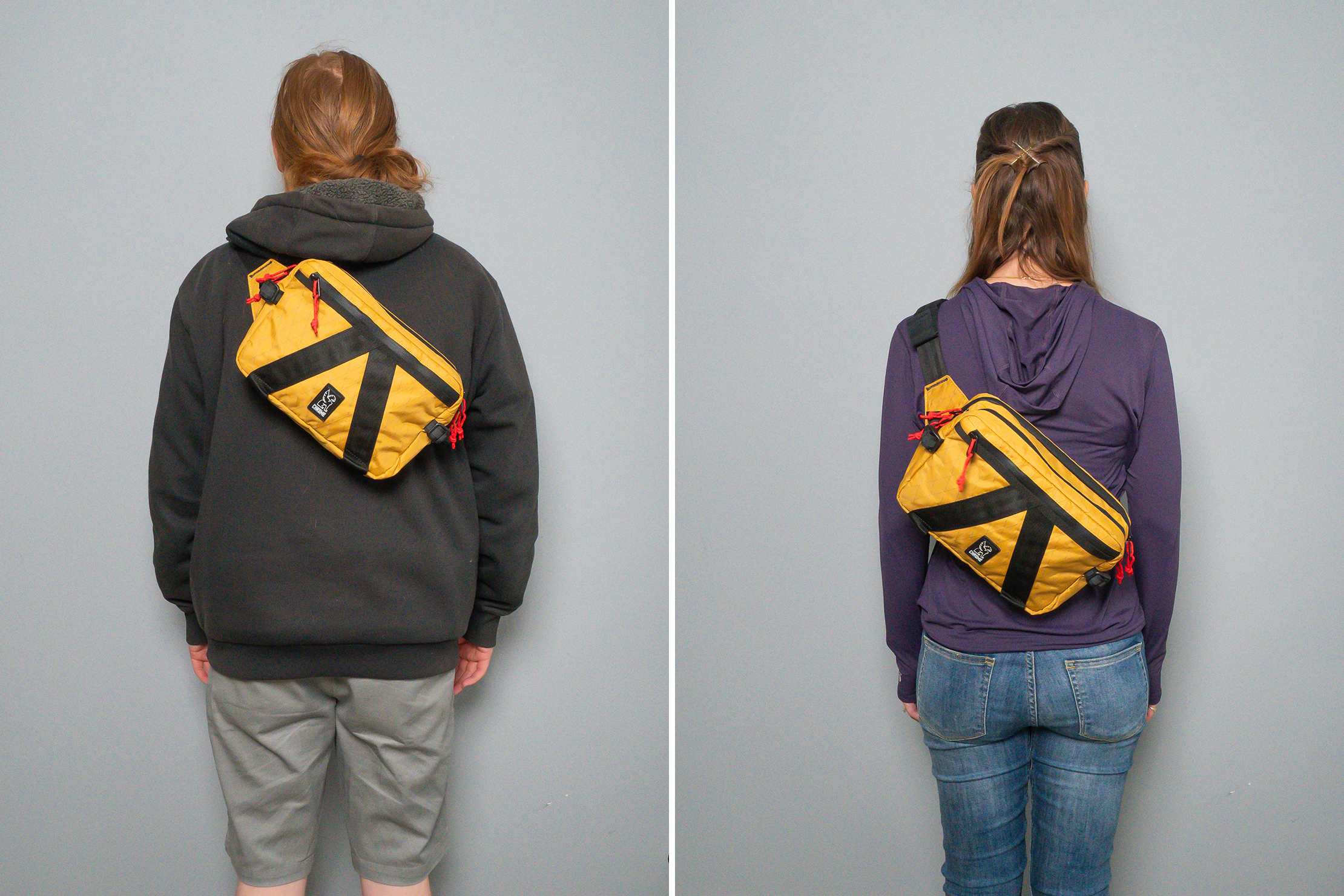
There’s little to no padding on the back panel and no aeration, either, but we think that’s not a huge deal because the materials are fairly lightweight. Whatever you stow in the back of the pack becomes the back panel, so if you pack smarter, this isn’t an issue. However, if you’re lugging around rocks or apples, it might be a little uncomfortable. Placing a tablet or a book on the back panel helps with comfort. With the light colorway we have on hand, it didn’t get too hot, but some of the darker ones might sweat things up a little.
The strap has no padding or aeration either, so it can dig in slightly at times. However, this is only the case with a thin shirt or tank top, or if you’ve got the sling stuffed to the gills. For most intents and purposes, it’s comfortable and easy to wear.
One side of the strap has a strap keeper to keep things organized, which is helpful if you plan to use this thing while you’re cycling. Nobody wants a strap flying around and getting caught in the spokes, right?
The other side has a hook-and-loop fastener, which is easy to adjust and enables you to remove or change the buckle. Since there’s no extra strap hanging around, it removes the need for strap keepers to keep the adjustment in check. However, this also means that you can’t freely adjust this side like you can the other, which is something we miss.
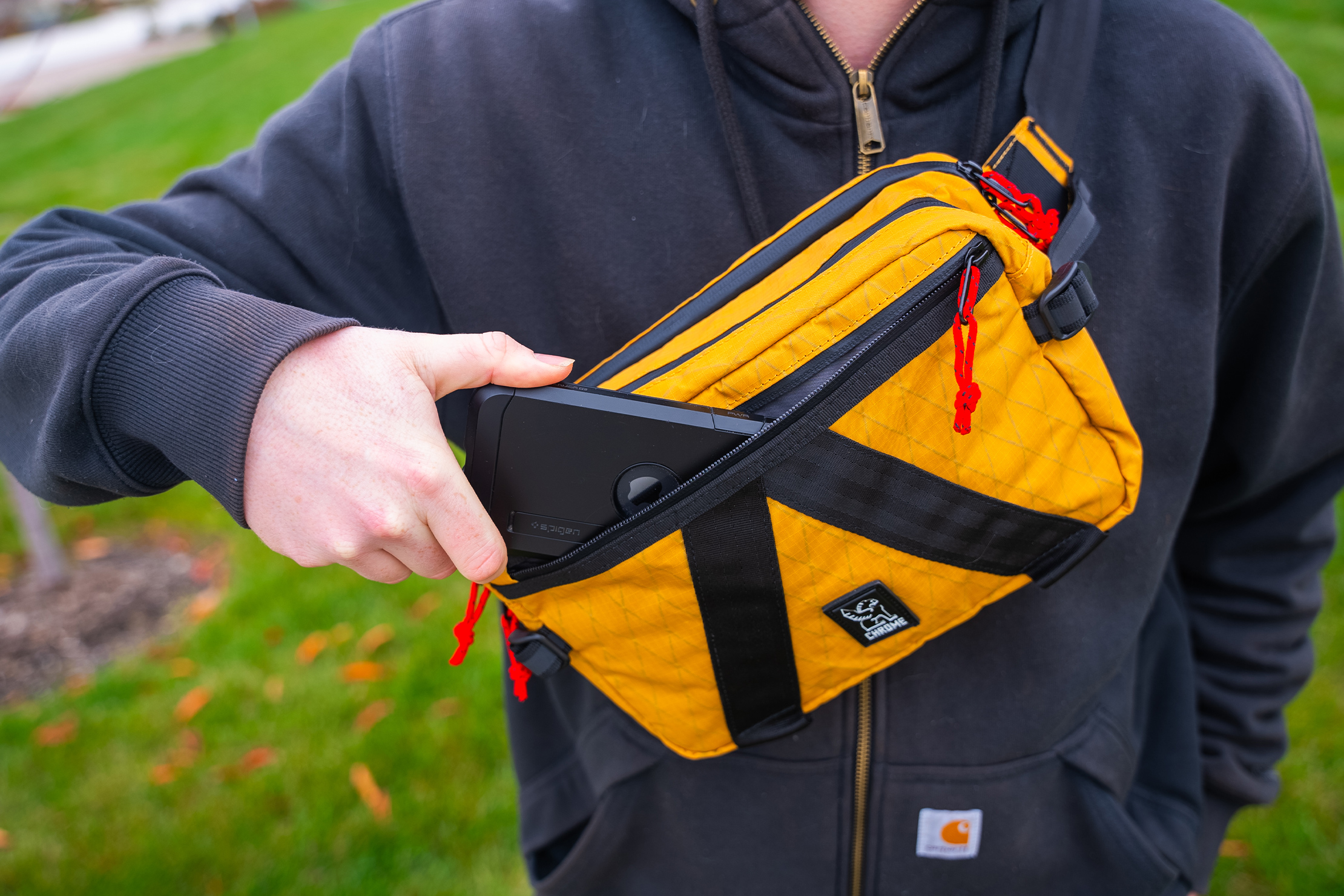
Depending on how you have the strap set up, the seat belt buckle can dig in slightly. You can modify it by changing how the strap is tightened, but it’s worth mentioning because it’s super apparent when the pack is full and heavy.
The edges have hip huggers, which add comfort. It’s a small piece of material that creates a transitional phase between the strap and the sling, which feels like you’re getting a hug.
Inside The Sling Bag
The foremost pocket takes up the whole front face of the pack, so there’s a good amount of space to work with. The front side doesn’t have much protection from bumps and knocks because the exterior fabric isn’t very thick. However, there’s a fair amount of padding on the back side, which is handy. If you put any electronics inside here, make sure to place the glass side facing inward.
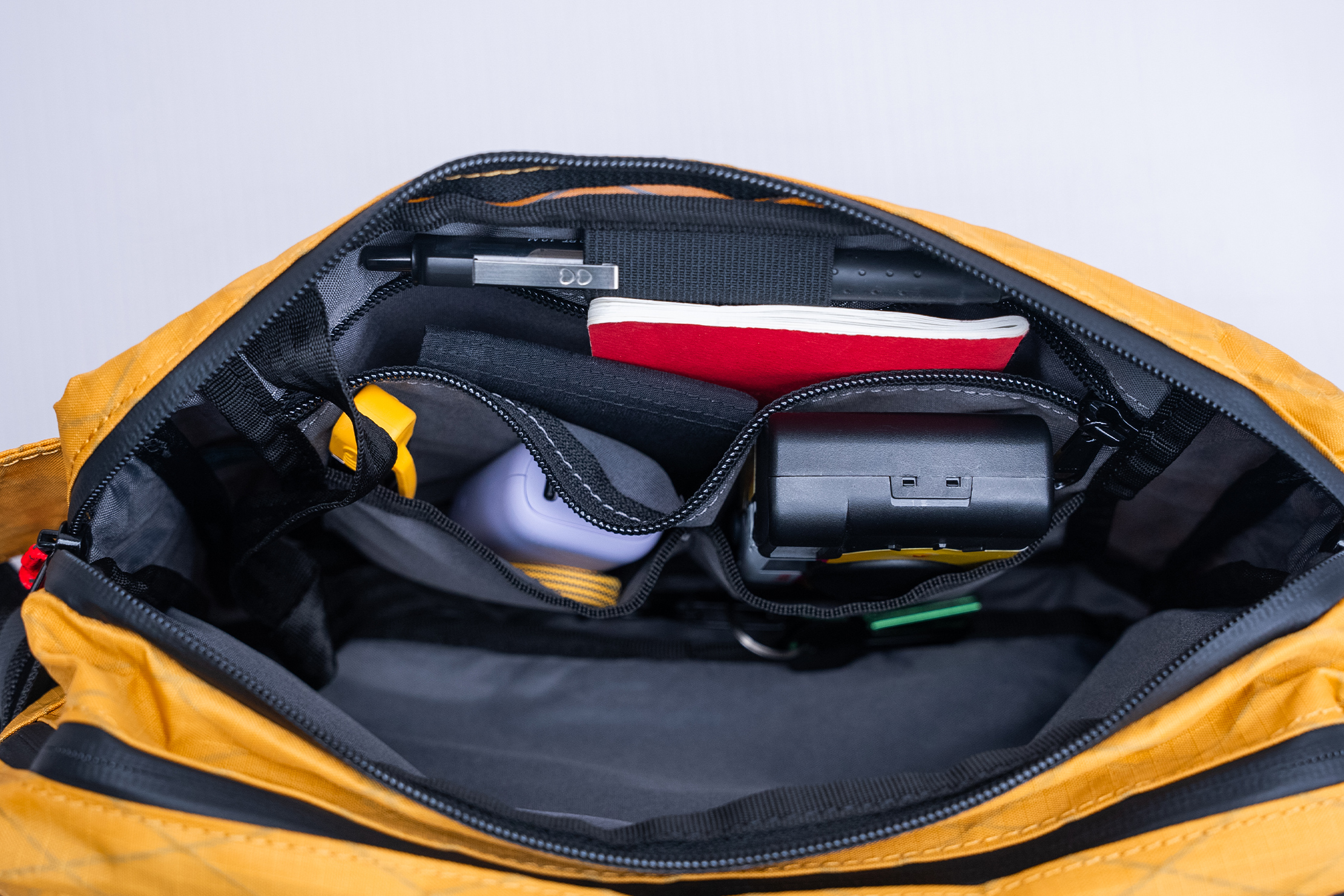
There’s no organization in the front pocket, but that’s fine because this is a good dump pocket for goodies you’ll use throughout the day that don’t need to be segmented. Snacks, a map, and a pair of headphones work well here. Smaller, loose items don’t do so well.
The middle compartment has lots of room with little organization, too. You can fit a ton of gear here, which we dig. There are three loops on the front side of the pack, ideal for stowing cycling tools, a multitool or gear shard, or other items you want to keep separate from goodies stowed inside the pack. Other than the loops, there’s no other organization present. However, there’s a lot of space for larger items, like a tablet, book, or Kindle. If you’re stowing tools here, electronics probably aren’t your best bet. However, space isn’t in short supply.
The back compartment is the only one with substantial organization, so this will do the bulk of the heavy lifting if you want to keep your gear segmented. All the organization is on a flap or tag, so you can stow things behind it if you want. This enables you to put something flat as the back panel without messing up the organization, which is ideal.
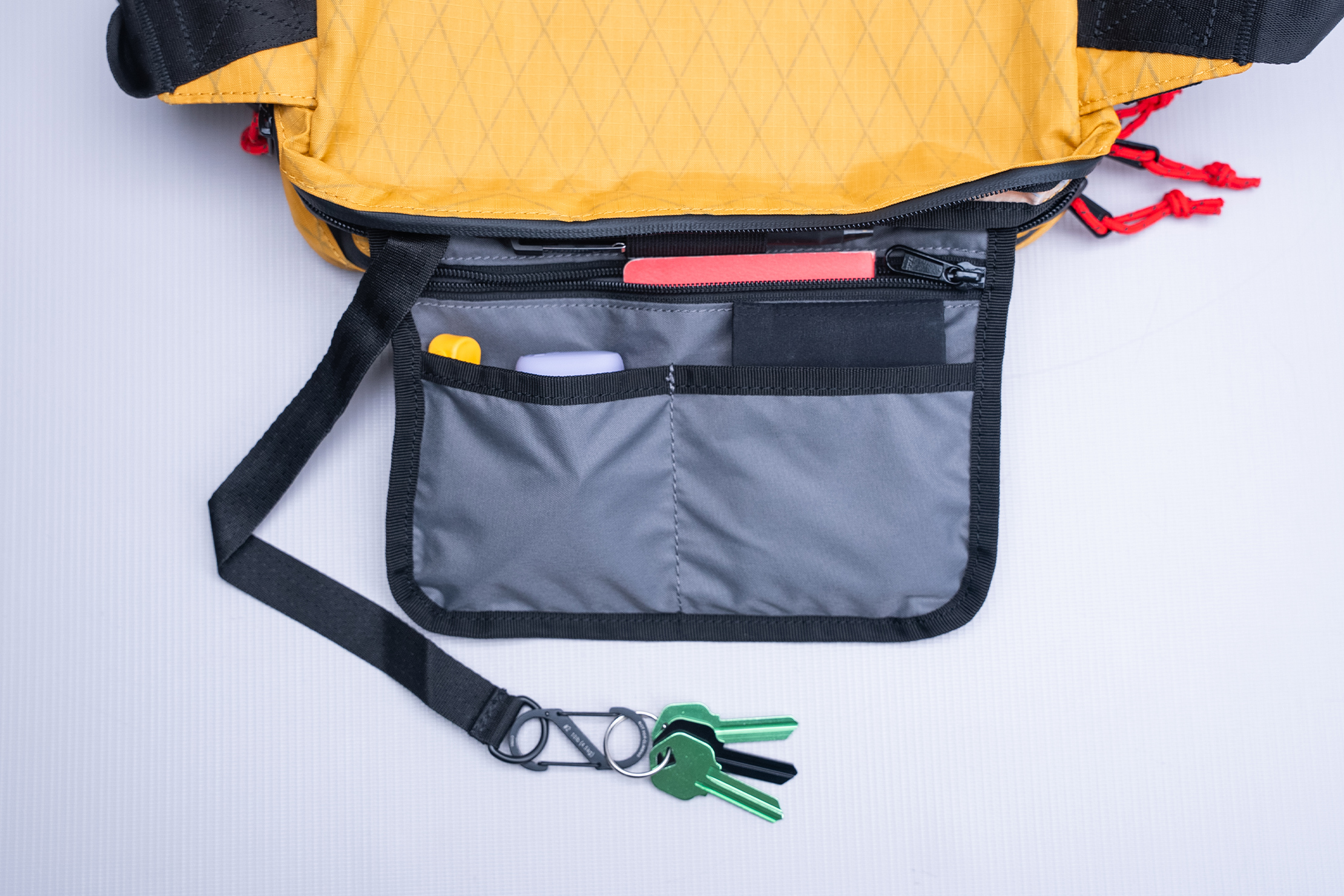
On the top is there’s an elastic loop where you can stow various things, from a pen to a socket wrench. It’s snappy and holds onto our items fairly well. On the left side, there’s a long key leash. We dig this length on a pack like this because it’s designed for commuting. The leash is long enough to open your apartment, hotel, or Airbnb door, so you don’t have to take your keys on and off constantly. It doesn’t have a clip, just a D-ring, so you’ll have to use a jump ring and feed it through each time you want to completely remove the key.
Below that is a zippered pocket, which is an excellent spot to lock down smaller items you don’t want bouncing around in any of the other compartments without organization. This is the only spot like this on this sling, so this is where you can stow those smaller, more important items. A passport works here, too.
Below that are two standard liner pockets. These work well for a phone, minimalist wallet, or similar-sized items. They’re nothing fancy, but we dig their inclusion because of how little organization there is elsewhere in the pack.
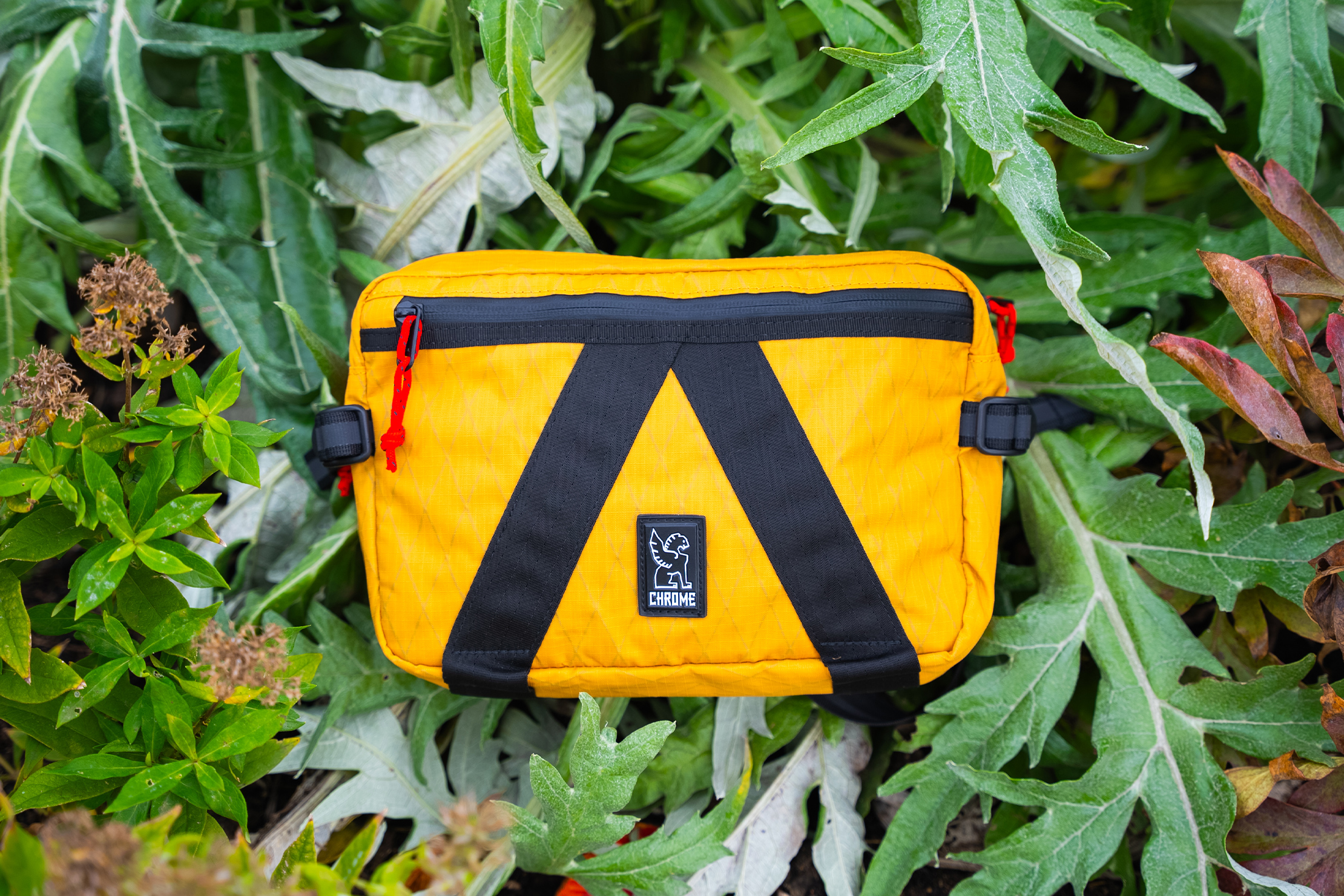
That’s it; that’s all the organization we’re working with inside this pocket and, more generally, inside the sling as a whole. We like the freedom that Chrome gives us with this bag. However, travelers who like to have organization in every pocket might not find what they want here.
It’s worth noting that none of the pockets are very deep, making it challenging to stow bulkier items inside. For example, you can fit a point-and-shoot camera of nearly any size inside without issue, even something larger like a Fuji X100-style rangefinder. However, something with a detachable lens, like a Fuji X-T camera, will be a tough fit because of how much depth it requires. You can make some smaller mirrorless cameras work, but depth isn’t your friend if you want to bring larger items along for the ride.
If you’re looking for a sling with durable, lightweight materials that works well for commuting and adventuring through a new city, the Chrome Industries Tensile Sling Bag might be for you!
Usage Timeline
Condition: Excellent
- We’re digging the look and feel of the lightweight materials
- The zipper pulls are easy to grab onto to open the main compartment
- We’re curious about how well the internal organization works
Condition: Excellent
- The materials and hardware have held up well
- Sometimes, the seat belt buckle digs in
- We dig the internal organization (or lack thereof)
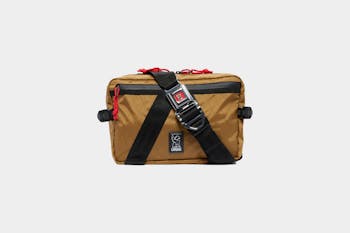






Get your questions about the Chrome Industries Tensile Sling Bag answered from our team and the Pro Community right here on the page. Plus, join discussions with other members about gear, guides, and more.
Join Pack Hacker Pro or, Sign In